Things to do in Hue
Hue is the former Royal Capital of Vietnam and the city's architecture and attractions reflect the legacy of opulent emperors and revered statesmen. Not only is its historic significance reflected in the city, but its natural beauty is also immediately apparent to visitors.
The Perfume River is one of the last places in Vietnam where the government hasn't removed those who dwell on and live off its rivers. The Royal Tombs and the Citadel lie along its banks, the final resting places and former home of some of Vietnam's most notable emperors. Hue harks back to an age where leaders were gods and the mystique of their status is evident at their elaborately constructed tombs.
Yet, it is not discordant with the present and the demilitarised zones and tunnels at Vinh Moc remind us of the atrocities of recent history. Here visitors can explore the tunnel systems of Vinh Moc, where local villagers hid and survived constant bombardment during the Vietnam War. Visitors shouldn't wander far off of the path though, as there is still enough unexploded ordnance in the jungles to fight another war.
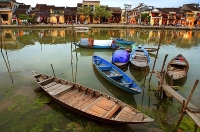
Hoi An
The quaint riverside town of Hoi An was an important port town and one of the major trading centres in South East Asia during the 16th and 17th centuries. The cultural influences o…
Hoi An
The quaint riverside town of Hoi An was an important port town and one of the major trading centres in South East Asia during the 16th and 17th centuries. The cultural influences of the Japanese and Chinese merchants are still evident today in the town's architecture, with the famous Japanese Covered Bridge and the distinctly Chinese atmosphere of the Old Quarter forming part of its unique character. A UNESCO-listed town, Hoi An has preserved much of its heritage and has remained largely void of traffic and pollution. Lining the narrow streets are two-storey Chinese shops, with charming wooden facades and tiled roofs, merchants' homes, Assembly Halls and temples that preserve an ancient character. On the 15th day of every lunar month, the ancient character of this sleepy town takes on fairytale proportions, as porches, streets and windows are lit by the glow of coloured lanterns; a practice reminiscent of the old days and aimed at retaining the spirit of the past. Hoi An is becoming an increasingly popular tourist destination, not only for its attractive old-world atmosphere and genuine friendliness, but also for its restaurants, serving delicious Hoi An specialities, and tailor-made clothes. Rows of little tailor shops with rolls of fine silk offer the chance to have beautiful garments made up within hours; however, the insistence of the tailors can be annoying. Two miles (4km) to the east of Hoi An is the beach of Cua Dai, considered to be one of the most beautiful beaches in Central Vietnam, with its long, white and sandy coastline. From Hoi An, visitors can make trips to the large marble rock formations 'The Marble Mountains', which are closer to Da Nang, or take a short river cruise. Travellers would be remiss not to take the time to visit Hoi An, if only to take a moment to bask in its history.
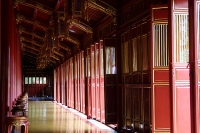
The Citadel
Constructed by Emperor Gia Long in 1804 for the private use of the emperor and his household, the enormous moated Citadel is comprised of three separate walled enclosures. The oute…
The Citadel
Constructed by Emperor Gia Long in 1804 for the private use of the emperor and his household, the enormous moated Citadel is comprised of three separate walled enclosures. The outer citadel, surrounded by a six mile (10km) perimeter wall, punctuated by 10 gates, frames the Imperial Enclosure used for official business. At the very centre is the Forbidden Purple City, the restricted residence of the emperor and his concubines. This once magnificent Imperial City originally included many magnificent features, with tombs, pagodas and temples, lakes and lavishly gilded pavilions. Today remnants of the palaces contain ornate ceremonial halls and throne rooms, mosaics adorn roofs and pillars, and beautiful landscaped gardens surround the remaining buildings. Sadly much was destroyed during the Vietnamese War, and a fire further damaged the Forbidden Purple City, but it is still possible to see evidence of its past glory. The main entrance is through the Ngo Mon Gate (Noon Gate), a stunning example of Nguyen architecture, with separate entrances for the emperor, his mandarins and the royal elephants. A soaring multi-roofed pavilion used for important royal proclamations, sits elegantly on top.
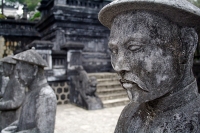
Royal Tombs
South of Hue are eight splendid royal tombs of the Nguyen emperors, situated among the hills on the banks of the Perfume River. Often designed while the emperor was still alive, ea…
Royal Tombs
South of Hue are eight splendid royal tombs of the Nguyen emperors, situated among the hills on the banks of the Perfume River. Often designed while the emperor was still alive, each mausoleum was built to serve as a palace for the afterlife. In this vein the tombs were built as vast complexes, each with traditional functions. These complexes include paved courtyards lined with mandarin statues of emperors, a stone stele inscribed with details of his reign, a main temple dedicated to the worship of the deceased and containing personal effects, and the tomb itself. Surrounding the complex were artificial ponds in a garden-like setting. The Tomb of Tu Dac, with its lotus-filled lake and central pavilion, the remarkable mosaics of Minh Mang's Tomb, and the simple and serene Tomb of Khai Dinh are the most interesting.
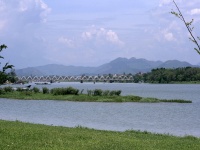
The Perfume River
A boat trip on the Perfume River is one of the highlights of a visit to Hue and includes stops to visit some of the city's main attractions. Passing other sampans (traditional rowi…
The Perfume River
A boat trip on the Perfume River is one of the highlights of a visit to Hue and includes stops to visit some of the city's main attractions. Passing other sampans (traditional rowing boats) on their way to the market, houseboats and dragon boats, a typical trip will take visitors to the Thien Mu Pagoda, Hon Chen Temple and the Royal Tombs. The Thien Mu Pagoda is one of the oldest and most attractive religious structures in Vietnam, dating back to 1601. Its most striking feature is the seven-tiered tower, representing the seven steps to enlightenment. Another way to experience the Perfume River is on an evening boat trip hosting a traditional folksong performance. This long-standing tradition goes back to the rule of the emperors when artists would play music and recite poetry from a rowing boat on the river.
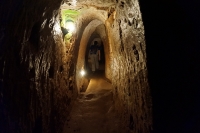
DMZ (Demilitarised Zone) and Vinh Moc
Under the Geneva Accords of 1954, Vietnam was split into North and South along the 17th parallel. The Ben Hai River was selected as the temporary demarcation line. A three-mile (5k…
DMZ (Demilitarised Zone) and Vinh Moc
Under the Geneva Accords of 1954, Vietnam was split into North and South along the 17th parallel. The Ben Hai River was selected as the temporary demarcation line. A three-mile (5km) strip of no-man's land on either side of the border was known as the DMZ or Demilitarised Zone. It was bombed into a desolate wasteland, riddled with land mines and surrounded by barbed wire during the war. The area surrounding the DMZ and the land in between was the worst affected, and the amount of explosives, napalm and chemicals used, including Agent Orange, has left the once heavily forested land with stunted growth and infertile soil. Historical sites and landmarks include the Hien Luong Bridge spanning the river, entry to the Ho Chi Minh Trail that bypassed the border, the American firebase at Con Thien, U.S Marine base at Khe Sanh, and the Truong Son War Martyr Cemetery dedicated to the thousands who died on the Ho Chi Minh Trail. A guided tour is strongly recommended as there are no signs and the area still contains unexploded landmines. Vinh Moc is known for the extraordinary complex of tunnels constructed by the villagers as an underground village in which to shelter from American bombardments. Faced with the total destruction of their village in 1965, they dug an underground network consisting of three layers starting at a depth of 33ft (10m) with room for 300 people, including wells, a school, clinics, storerooms, observation posts, ventilation shafts and a maternity room where 17 babies were delivered during the war. A section has been restored and is open to visitors and there is a small museum at the entrance.



